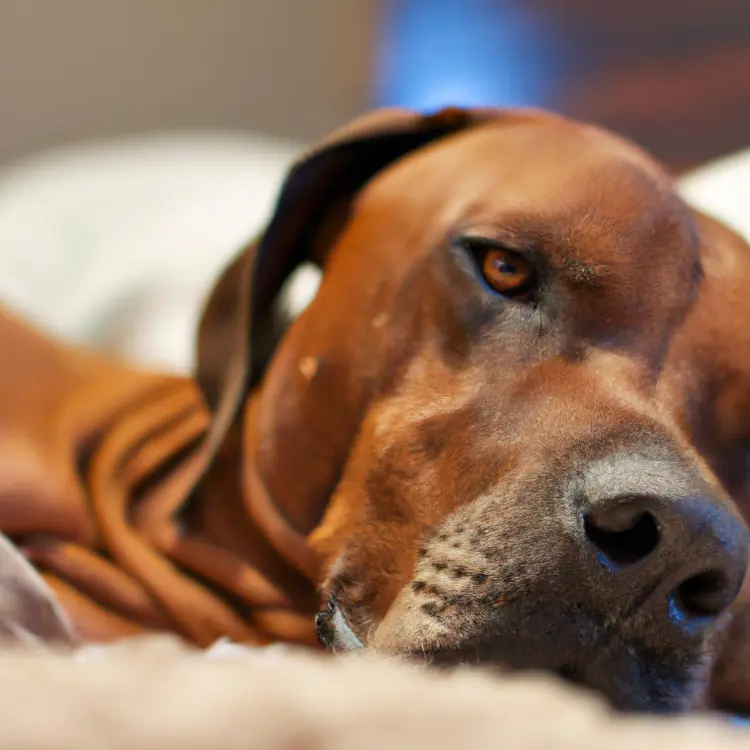Rhodesian Ridgebacks, known for their distinctive ridge of hair along their spines, are popular dogs. However, they can be susceptible to certain health conditions, including dermoid sinus. This article will explore dermoid sinus and how it affects Rhodesian Ridgebacks.
Table of contents
Key Takeaways
- Rhodesian Ridgebacks and Dermoid Sinus: Dermoid sinus is a congenital condition found in Rhodesian Ridgebacks. It is important for owners to understand the causes, symptoms, and treatment options for this condition to ensure the well-being of their dogs.
- Causes and Identification: Dermoid sinus is caused by a failure of the neural tube closure during development. It can be identified by a sinus-like opening on the back of the dog. Early detection is essential for timely management.
- Treatment and Prevention: Treatment options for dermoid sinus include surgical removal and proper wound management. While prevention may not be possible, responsible breeding practices can help minimize the occurrence of this condition in future generations.
What Is Dermoid Sinus in Rhodesian Ridgebacks?
Dermoid sinus is a congenital condition in Rhodesian Ridgebacks. It is a tube-like structure that forms along the midline of the back. This condition is present at birth and is caused by a skin failure to close properly during embryonic development.
Dermoid sinus can range in severity from a small superficial sinus to a larger, deeper one that may extend towards the spinal cord. Not all Rhodesian Ridgebacks will develop a dermoid sinus, but those that do may need surgery to remove the sinus and prevent complications.
If not treated, dermoid sinus can cause infections, abscesses, and neurological issues. Rhodesian Ridgeback owners should know this condition and monitor their dogs for signs or symptoms. Regular veterinary check-ups are recommended to detect and address dermatoid sinuses early.
What Causes Dermoid Sinus in Rhodesian Ridgebacks?
Dermoid sinus is caused by a genetic mutation that affects the development of the skin and underlying tissues in the breed. The specific gene responsible for this condition is not yet identified, but it is believed to be inherited in an autosomal recessive manner. Both parents must carry the gene for the condition to be passed on to their offspring.
The development of dermoid sinus occurs during embryonic development when the skin and neural tissue fail to separate properly. This forms a sinus tract that connects the skin surface to deeper tissues. In Rhodesian Ridgebacks, these sinus tracts typically occur along the midline of the back but can also be found in other areas.
The severity of dermoid sinus in Rhodesian Ridgebacks can vary. Some dogs have only a small opening in the skin, while others have more complex sinus tracts. The condition can also be associated with other congenital abnormalities, such as spinal cord defects.
Breeders should screen their Rhodesian Ridgebacks for dermoid sinus and avoid breeding dogs that carry the gene for the condition. By doing so, they can reduce the incidence of dermoid sinus in the breed and ensure healthier puppies.
Symptoms and Signs of Dermoid Sinus
In Rhodesian Ridgebacks, the raised, ridge-like skin along the spine is a unique characteristic. Within the first few weeks of a puppy’s life, there may be a visible or palpable opening in the skin along the ridge. This opening can be accompanied by a discharge ranging from clear to thick and pus-like.
Infection may be indicated by swelling and inflammation around the sinus opening, causing pain or discomfort in the affected area. This can lead to abscesses or cysts near the sinus opening. The affected area may also exhibit increased grooming or scratching behavior.
Recurring infections in the sinus can result in the development of secondary infections, such as cellulitis or pyoderma. In severe cases where the infection spreads, symptoms of systemic illness may occur, including fever, lethargy, or loss of appetite.
The severity of these symptoms and signs of dermoid sinus can vary depending on the dog and the stage of the condition. Consulting a veterinarian for proper diagnosis and treatment is important, as untreated dermoid sinus can lead to serious complications.
How to Identify Dermoid Sinus in Rhodesian Ridgebacks?
To identify dermoid sinus in Rhodesian Ridgebacks, look for the following signs and symptoms:
presence of an opening or dimple on the back, between the shoulder blades; discharge or pus coming from the opening; redness, swelling, or inflammation around the area; and your dog may show discomfort or pain when the area is touched.
If you notice these symptoms, consult a veterinarian for a proper diagnosis. They will perform an examination and recommend tests like X-rays or ultrasounds to confirm dermoid sinus. Early identification of dermoid sinus in is crucial, as untreated dermoid sinus can lead to severe complications.
Treatment options for dermoid sinus in Rhodesian Ridgebacks may include surgical removal and closure of the sinus tract. To prevent dermoid sinus, research the lineage and ask the breeder about its presence in their breeding stock. Regularly inspect your Rhodesian Ridgeback’s back and seek veterinary attention if you suspect dermoid sinus. You can ensure your pet’s well-being by being aware of the signs and symptoms of the dermoid sinus in Rhodesian Ridgebacks.
Diagnosis and Treatment of Dermoid Sinus
Diagnosis and Treatment of Dermoid Sinus in Rhodesian Ridgebacks can be accomplished by following these steps:
1. Begin by conducting a thorough physical examination of the affected Rhodesian Ridgeback to identify any abnormalities in the skin.
2. Utilize imaging tests like X-rays or CT scans to evaluate the condition and determine the extent and precise location of the dermoid sinus.
3. Perform surgery to remove the dermoid sinus and excise any accompanying cysts or masses. It is crucial to completely eliminate the sinus tract to prevent recurrence.
4. Offer post-operative care, which includes attending to the wound, closely monitoring for any signs of infection, and administering pain medications and antibiotics to facilitate healing.
If you suspect that your Rhodesian Ridgeback is suffering from a dermoid sinus, it is imperative to seek the expertise of a veterinarian for an accurate diagnosis and a well-planned treatment approach. Early detection and intervention are key in avoiding complications and ensuring a successful outcome.
What Are the Options for Treating Dermoid Sinus in Ridgebacks?
What Are the Options for Treating Dermoid Sinus in Rhodesian Ridgebacks?
There are various options available for treating dermoid sinus in Rhodesian Ridgebacks. One of the options is surgical removal, which is highly recommended for increasing comfort and reducing the risk of infection. The surgical procedure involves the removal of the sinus tract to prevent any potential complications.
Another option is laser therapy, which provides a non-surgical approach to closing the sinuses. This advanced treatment method utilizes lasers to seal the sinus, effectively preventing any chances of infection. Laser therapy is particularly suitable for Ridgebacks who are unsuitable for surgery and offers a minimally invasive solution.
In more complex cases, ongoing management and monitoring are essential. This includes regular cleaning and administering medication as prescribed by the veterinarian. It is crucial for Ridgeback owners to work closely with their veterinarians to determine the most suitable and effective treatment option for their beloved pets.
By considering these various options and consulting with a veterinarian, owners can ensure that their Rhodesian Ridgebacks receive the proper care and management required to effectively address dermoid sinus.
How Is Dermoid Sinus in Ridgebacks Diagnosed?
To diagnose dermoid sinus in Rhodesian Ridgebacks, veterinarians typically follow a sequence of steps.
First, they conduct a physical examination of the affected dog. During this examination, the veterinarian searches for visible signs of dermoid sinus, such as skin openings or protruding hair follicles.
Next, imaging tests are performed. X-rays or ultrasound are used to evaluate the sinus tracts’ depth and extent and identify any underlying abnormalities. These tests are essential for obtaining a clear understanding of the condition.
If dermoid sinus is suspected, a biopsy is conducted. A tissue sample is taken for analysis to confirm the diagnosis and to rule out other possible conditions. This analysis is crucial to ensure accurate results and proper treatment.
Since dermoid sinus is a hereditary condition, genetic testing is also recommended. This testing can identify dogs that carry the responsible gene for dermoid sinus. By identifying carriers, breeders can make informed decisions to prevent the transmission of this condition to future generations.
In complex cases or for breeders dealing with dermoid sinus, collaborative evaluation with veterinary dermatologists or specialists in genetic disorders can be extremely valuable. Their expertise and insights can assist in developing effective treatment plans or breeding strategies.
Prompt diagnosis of dermoid sinus in Rhodesian Ridgebacks is essential for timely treatment and prevention of complications. Regular veterinary check-ups and thorough examinations play a significant role in detecting and intervening early.
Prevention and Management of Dermoid Sinus in Rhodesian Ridgebacks
Veterinary check-ups are vital in detecting and managing dermoid sinus in Rhodesian Ridgebacks. Regular visits to the veterinarian help in early detection and effective management of this condition.
Responsible breeding is also essential to minimize the risk of dermoid sinus. Breeders should screen both parents for dermoid sinus to ensure responsible breeding practices and reduce the chances of passing the condition to the offspring.
Surgical removal is the most effective treatment for dermoid sinus. Consulting an experienced veterinarian for the surgical removal of the dermoid sinus is highly recommended. They will provide appropriate guidance and perform the surgery with expertise.
Post-operative care is crucial for the successful management of dermoid sinus. It is important to clean the surgical site thoroughly and monitor the healing process. This will ensure proper recovery and minimize the risk of complications.
Preventing infection is another important aspect of managing dermoid sinus. Regularly cleaning the affected area is necessary to minimize the risk of infection. This will promote faster healing and reduce the condition’s impact on the dog’s health.
By following these strategies, Rhodesian Ridgeback owners can ensure their dogs’ well-being and minimize the dermoid sinus’s impact on their health. Early detection, responsible breeding, surgical removal, post-operative care, and infection prevention are key elements in retaining dermoid sinus in Ridgebacks.
How to Manage and Care for Rhodesian Ridgebacks with Dermoid Sinus?
Managing and caring for Rhodesian Ridgebacks with Dermoid Sinus requires special attention and care to ensure their well-being. Here are some tips on how to properly care for them:
- Schedule regular check-ups with an experienced veterinarian specializing in treating Dermoid Sinus. This will help monitor the condition and ensure prompt treatment if any issues arise.
- Regularly clean the area around the Dermoid Sinus to prevent infections. It is important to use a mild antiseptic solution recommended by the veterinarian for gentle cleaning.
- Avoid excessive scratching or rubbing of the affected area to prevent aggravation of the condition and relieves discomfort or itchiness.
- Maintain the overall health of Rhodesian Ridgebacks by providing them with a nutritious and balanced diet. Consult a veterinarian to determine the appropriate diet that meets their nutritional requirements.
- Ensure regular exercise for the overall well-being of Rhodesian Ridgebacks. However, avoiding activities that strain or put pressure on the affected area is important. Consult with a veterinarian for suitable exercise routines.
- Keep a close eye on the affected area for changes such as swelling, discharge, or increased discomfort. If you notice any changes, it is important to contact your veterinarian immediately for further guidance.
So, by following these guidelines, you can effectively manage and care for your Rhodesian Ridgeback with Dermoid Sinus to ensure their well-being and happiness.
Frequently Asked Questions
A: A Rhodesian Ridgeback is a breed of dog known for the ridge of hair along its back, running in the opposite direction to the rest of its coat.
A: Dermoid Sinus is a congenital condition found in dogs, characterized by a sinus tract that extends from the skin to the spinal column.
A: Dermoid Sinus in Rhodesian Ridgebacks is diagnosed through physical examination and imaging techniques such as MRI and CT scans.
A: Dermoid Sinus is a relatively rare condition, but it is more prevalent in Rhodesian Ridgeback dogs than other breeds.
A: The exact cause of Dermoid Sinus in Rhodesian Ridgebacks is not fully understood, but it is believed to be a result of a neural tube defect during embryonic development.
A: Yes, Dermoid Sinus in can be surgically treated through complete excision of the sinus tract and affected tissues.
A: Symptoms of Dermoid Sinus in Rhodesian Ridgebacks may include skin debris, spinal pain, swelling along the dorsal midline, and openings on the skin.
A: Yes, Dermoid Sinus in Rhodesian Ridgebacks has a hereditary component and is believed to be inherited through multiple genes.
A: In some cases, Dermoid Sinus can lead to secondary complications such as myelitis, meningomyelitis, and spinal cord compression.
A: Dermoid Sinus is predominantly found in Rhodesian Ridgebacks, but there have been a few isolated cases reported in other breeds as well.





